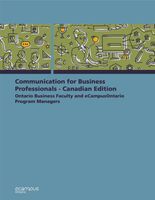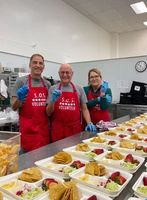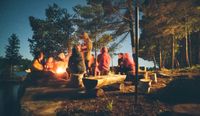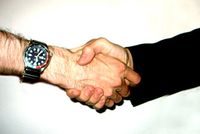Explore web search results related to this domain and discover relevant information.
By definition, a rotation about ... (so it is an isometry), and orientation (i.e., handedness of space). Composing two rotations results in another rotation, every rotation has a unique inverse rotation, and the identity map satisfies the definition of a rotation. Owing to the above properties (along composite rotations' associative property), the set of all rotations is a group under ...
By definition, a rotation about the origin is a transformation that preserves the origin, Euclidean distance (so it is an isometry), and orientation (i.e., handedness of space). Composing two rotations results in another rotation, every rotation has a unique inverse rotation, and the identity map satisfies the definition of a rotation. Owing to the above properties (along composite rotations' associative property), the set of all rotations is a group under composition.These matrices are known as "special orthogonal matrices", explaining the notation SO(3). The group SO(3) is used to describe the possible rotational symmetries of an object, as well as the possible orientations of an object in space.The group of all 3 × 3 orthogonal matrices is denoted O(3), and consists of all proper and improper rotations. In addition to preserving length, proper rotations must also preserve orientation. A matrix will preserve or reverse orientation according to whether the determinant of the matrix is positive or negative. For an orthogonal matrix R, note that det RT = det R implies (det R)2 = 1, so that det R = ±1.Thus every rotation can be represented uniquely by an orthogonal matrix with unit determinant. Moreover, since composition of rotations corresponds to matrix multiplication, the rotation group is isomorphic to the special orthogonal group SO(3).In the next section, this representation of rotations is used to identify SO(3) topologically with three-dimensional real projective space. The Lie group SO(3) is diffeomorphic to the real projective space
This is one of the classical Lie groups. It is the connected component of the neutral element in the orthogonal group ... SO(2) the circle group.
In physics the rotation group is related to angular momentum. On the ordinary cohomology of the classifying spaces ... the case of SO(8) is special, since in the ADE classification of simple Lie groups it corresponds to D4, which makes its representation theory enjoy triality.For general references see also at orthogonal group. ... John Milnor, Jim Stasheff, Characteristic classes, Princeton Univ. Press (1974) [ISBN:9780691081229, doi:10.1515/9781400881826, pdf] Edgar H. Brown, The Cohomology of ... BO_n with Integer Coefficients, Proceedings of the American Mathematical Society Vol.Harsh Pittie, The integral homology and cohomology rings of SO(n) and Spin(n), Journal of Pure and Applied Algebra Volume 73, Issue 2, 19 August 1991, Pages 105–153 (doi:10.1016/0022-4049(91)90108-E)EditDiscussPrevious revisionChanges from previous revisionHistory (25 revisions) Cite Print Source
SO GROUP LTD - Free company information from Companies House including registered office address, filing history, accounts, annual return, officers, charges, business activity
We use some essential cookies to make our services work.We'd also like to use analytics cookies so we can understand how you use our services and to make improvements.

R) to the matrices of determinant equal to 1 is called the special orthogonal group in n dimensions on ... R) or simply SO(n).
AI generated definition based on: Many-Sorted Algebras for Deep Learning and Quantum Technology, 2024 ... Press Enter to select rating, 1 out of 3 starsPress Enter to select rating, 2 out of 3 starsPress Enter to select rating, 3 out of 3 stars ... You might find these chapters and articles relevant to this topic. ... R endowed with the matrix multiplication constitutes a continuous group (in fact, a Lie group) referred to as the orthogonal group in n dimensions onR) to the matrices of determinant equal to 1 is called the special orthogonal group in n dimensions on ... R) or simply SO(n).Obviously, SO(n, ... R). We have the chain of groupsThere are similar constructions of flag manifolds for other classical groups. We will consider only the minimal flag manifolds. For ... which is well defined in the homogeneous coordinates (compatible with the equivalency classes) and defines isotropic subspaces relative to I. This matrix cone is preserved by the subgroup ... then in inhomogeneous coordinates (z is a square k-matrix) this equation is transformed into the condition that the matrix z is skew-symmetric. So, in a natural sense, the isotropic Grassmannian is the compactification of the linear space of skew-symmetric matrices
The special orthogonal group \(\mathbf{SO}(3)\) is one of the most important Lie groups encountered in robotics. It is the most natural way to represent rotations and orientations of rigid bodies in 3D. Because of how important 3D rotations are, there are many ways to understand and approach them.
The special orthogonal group \(\mathbf{SO}(3)\) is one of the most important Lie groups encountered in robotics. It is the most natural way to represent rotations and orientations of rigid bodies in 3D. Because of how important 3D rotations are, there are many ways to understand and approach them.In any case, the procedure provided here will return a matrix \(R \in \mathbf{SO}(3)\) that minimises the Euclidean (Frobenius) distance to \(M\), although this matrix may not actually be a unique solution to the original problem. The special orthogonal group in 3D is a beautiful and classical example of a Lie group, and it is of interest for both theoretical and practical reasons.My view is that, if you have a problem involving 3D rotations, your first choice should be to use the group \(\mathbf{SO}(3)\). It is sometimes worth using Euler angles or unit quaternions, but without some motivation for this, I would stick to the matrix Lie group.So the group is indeed closed under inversion.

Most humans form self-identities through their communication with others, and much of that interaction occurs in a group context. A group may be defined as three or more individuals who affiliate, interact, or cooperate in a familial, social, or work context.
Groups can be discussed in terms of their relationship to the individual and the degree to which they meet interpersonal needs. Some groups may be assembled at work to solve problems, and once the challenge has been resolved, they may dissolve into previous or yet to be determined groups.In business, you may have colleagues that are marketing experts that are members of the marketing department and perceive their tasks differently from a member of the sales staff or someone in accounting. You may work in the mailroom, and the mailroom staff is a group in itself, both distinct from and interconnected with the larger organization.In a work context, “affection” may sound odd, but we all experience affection at work in the form of friendly comments like “good morning,” “have a nice weekend,” and “good job!” Our professional lives also fulfill more than just our basic needs (i.e., air, food, and water, as well as safety). While your work group may be gathered together with common goals, such as to deliver the mail in a timely fashion to the corresponding departments and individuals, your daily interactions may well go beyond this functional perspective.There are fundamentally two types of groups, primary and secondary. The hierarchy denotes the degree to which the group(s) meet your interpersonal needs. Primary groups meet most, if not all, of one’s needs. Groups that meet some, but not all, needs are called secondary groups.
Emphasis since the spring has been on understanding the relationships among Weyl group representations, reductive group representations, and nilpotent orbits. Some of my papers, (including slides from an introduction to the orbit method given at Bert Kostant's birthday conference in May, 2008), ...

SO Group has been plucked from administration and has been acquired by The Freeman Company. Freeman and SO Group revealed the news on...
The business and assets of SO Group, and its subsidiary 360 Creative Event Services, will be incorporated into the Freeman family of brands and the business will operate under the trade name SO Group, a Freeman Company.Freeman and SO Group revealed the news on Thursday evening and announced that the business and assets of SO Group have been bought.Freeman emerged as the successful bidder for SO Group in an accelerated sales process following administration.“The two businesses share a similar culture, complementary services and a shared commitment to delivering exceptional customer experience,” said David Walley, chief executive officer of SO Group.
Secular and non-partisan, it promotes a genuine social vision focused on the common good. With 26,000 employees, 2 million beneficiaries each year, and a presence in 50 countries, Groupe SOS demonstrates that large-scale impact is both desirable and achievable in building a fairer and more ...
Secular and non-partisan, it promotes a genuine social vision focused on the common good. With 26,000 employees, 2 million beneficiaries each year, and a presence in 50 countries, Groupe SOS demonstrates that large-scale impact is both desirable and achievable in building a fairer and more inclusive future.Prove that society can undergo a positive and profound change. Since its creation almost 40 years ago, Groupe SOS has had one single ambition: to give a global response adapted to individual issues and bring about a fairer society.SOS Habitat et Soins is born to respond to the AIDS crisis. It offers new and diversified answers, especially housing solutions for people suffering from poverty or chronic illnesses related to AIDS. Groupe SOS opens La Corniche in Marseille, the very first program to help underaged drug addicts.This centre offers personalised support, favouring sustainable social inclusion. The Groupe SOS real-estate cooperative is created. By owning the buildings it operates in, Groupe SOS ensures the durability of the activities of its organisations and that their beneficiaries receive the very best accommodation.

Formed groups are those that come together through some outside influence or intervention. They usually have some sponsorship or affiliation and are convened for a particular purpose. Some examples of formed groups are therapy groups, educational groups, committees, social action groups, and teams.
As Klein (1972) notes, “purpose guides group composition”. It also helps guide the group’s selection of goal-directed activities and defines the broad parameters of the services to be provided. (getButton) #text=(Social Work Material) #icon=(demo)(getButton) #text=(Social Casework) #icon=(demo)(getButton) #text=(Social Group Work) #icon=(demo)(getButton) #text=(Teaching Job) #icon=(demo)(getButton) #text=(Assistant Professor Jobs) #icon=(demo)(getButton) #text=(Govt.In this text, the term treatment group is used to signify a group whose major purpose is to meet members’ socio-emotional needs. The purposes for forming treatment groups might include meeting members’ needs for mutual aid, support, education, therapy, growth, and socialization.Six primary purposes for treatment groups are (1) support, (2) education, (3) growth, (4) therapy, (5) socialization, and (6) self-help. In practice settings, there are innumerable variations of treatment groups that combine these six primary purposes. For example, a group for parents of children with Down syndrome might be oriented toward both education and growth.Support groups can be distinguished from other groups using supportive intervention strategies by their primary goals: to foster mutual aid, to help members cope with stressful life events, and to revitalize and enhance members’ coping abilities so they can effectively adapt to and cope with future stressful life events.
I am a beginner in group theory. Now reading a note of Lie group. I am confusing about the dimension of the group and the notation. For example, from my understanding, the dimension of SO(2) is 1 b...
I am a beginner in group theory. Now reading a note of Lie group. I am confusing about the dimension of the group and the notation. For example, from my understanding, the dimension of SO(2) is 1 because only one parameter (rotation angle) is used to parameterise the group.$\begingroup$ but there is also a 1D irrep for SO(2), which is $e^{i \theta}$, isn't it? $\endgroup$ ... $\begingroup$ Each of these groups has representations in many different dimensions. The numeral $2$ refers not to other dimensions of representations. Instead it refers solely to the dimension of the vector space in the definition of the group.$\begingroup$ In each case the $2$ refers to the size of the matrix. $SO(2)$ is the group of $2 \times 2$ real orthogonal matrices. $SU(2)$ is the group of $2 \times 2$ complex unitary matrices.The group $SO(2)$ is defined to be the group of $2 \times 2$ real orthogonal matrices (the vector space being $\mathbb{R}^2$ over $\mathbb{R}$). The group $SU(2)$ is defined to be the group of $2 \times 2$ complex unitary matrices (the vector space being $\mathbb{C}^2$ over $\mathbb{C}$).


Define a reference group and provide one example of such a group. Explain the importance of networks in a modern society.
It is easy to see from this definition that we all belong to many types of social groups: our families, our different friendship groups, the sociology class and other courses we attend, our workplaces, the clubs and organizations to which we belong, and so forth.Even people who live by themselves still interact with family members, coworkers, and friends and to this extent still have several group memberships. It is important here to distinguish social groups from two related concepts: social categories and social aggregates.Falling between a social category and a social group is the social aggregate, which is a collection of people who are in the same place at the same time but who otherwise do not necessarily interact, except in the most superficial of ways, or have anything else in common.The crowd at a sporting event and the audience at a movie or play are common examples of social aggregates. These collections of people are not a social category, because the people are together physically, and they are also not a group, because they do not really interact and do not have a common identity unrelated to being in the crowd or audience at that moment.

In the late 1990s a group of community members became concerned about providing a safe refuge for dislocated families, abused women and others in need. Volunteers like Elizabeth Kemp and her “brown baggers” began feeding unhoused people, and Sy Lenz’ efforts brought needed attention to the community of helping the unhoused. Thus the Haven was born. In 2003 SOS ...
In the late 1990s a group of community members became concerned about providing a safe refuge for dislocated families, abused women and others in need. Volunteers like Elizabeth Kemp and her “brown baggers” began feeding unhoused people, and Sy Lenz’ efforts brought needed attention to the community of helping the unhoused. Thus the Haven was born. In 2003 SOS (Sonoma Overnight Shelter) was formed.An active board worked to provide the safe refuge that was once only imagined. Kathy King became the Executive Director and embarked upon serving a community of people in need. She recruited volunteers and added some paid staff.Organizations like SOS are often the reflection of the dedication of individuals, and their energy and commitment to their mission is powerful. When the need of the community is great, and when it comes to food insecurity, constantly growing, that powerful energy can only go so far, however.Why it is that in 2025 hunger is such an enormous problem in America generally and Sonoma Valley specifically is a valid question, and we don’t presume to have the answer. That food insecurity is so persistent in our society is, frankly, shameful and confusing.

Groups are a fundamental part of social life. As we will see they can be very small – just two people – or very large. They can be highly rewarding to their members and to society as a whole, but there are also significant problems and dangers with them. All this makes them an essential ...
Groups are a fundamental part of social life. As we will see they can be very small – just two people – or very large. They can be highly rewarding to their members and to society as a whole, but there are also significant problems and dangers with them. All this makes them an essential focus for research, exploration and action.In this piece I want to examine some of the key definitions of groups that have appeared, review central ways of categorizing groups, explore important dimensions of groups, and look briefly at the group in time.Just how we define ‘group’ and the characteristics or ideas we use has been a matter of debate for many years. The significance of collectivities like families, friendship circles, and tribes and clans has been long recognized, but it is really only in the last century or so that groups were studied scientifically and theory developed (Mills 1967: 3).In the last decade of the nineteenth century, Émile Durkheim established just how wrapped up individual identity was with group membership, and Gustave Le Bon argued that people changed as they joined groupings such as crowds. Soon North American sociologists such as Charles Horton Cooley (1909) began to theorize groups more closely – and this was followed by others looking at particular aspects or types of group.
It follows from this equation that the square of the determinant of Q equals 1, and thus the determinant of Q is either 1 or −1. The orthogonal matrices with determinant 1 form a subgroup called the special orthogonal group, denoted SO(n), consisting of all direct isometries of O(n), which ...
In mathematics, the orthogonal group in dimension n, denoted O(n), is the group of distance-preserving transformations of a Euclidean space of dimension n that preserve a fixed point, where the group operation is given by composing transformations. The orthogonal group is sometimes called the general orthogonal group, by analogy with the general linear group.The one that contains the identity element is a normal subgroup, called the special orthogonal group, and denoted SO(n). It consists of all orthogonal matrices of determinant 1. This group is also called the rotation group, generalizing the fact that in dimensions 2 and 3, its elements are the usual rotations around a point (in dimension 2) or a line (in dimension 3).More generally, given a non-degenerate symmetric bilinear form or quadratic form on a vector space over a field, the orthogonal group of the form is the group of invertible linear maps that preserve the form. The preceding orthogonal groups are the special case where, on some basis, the bilinear form is the dot product, or, equivalently, the quadratic form is the sum of the square of the coordinates.So, the translations form a normal subgroup of E(n), the stabilizers of two points are conjugate under the action of the translations, and all stabilizers are isomorphic to O(n). Moreover, the Euclidean group is a semidirect product of O(n) and the group of translations.It follows from this equation that the square of the determinant of Q equals 1, and thus the determinant of Q is either 1 or −1. The orthogonal matrices with determinant 1 form a subgroup called the special orthogonal group, denoted SO(n), consisting of all direct isometries of O(n), which are those that preserve the orientation of the space.


US-based events company Freeman has bought SO Group out of administration to give it a foothold in the UK.
The deal was concluded on 28 March - the day So Group went into administration.It will see the Birmingham-based event services firm, and its subsidiary 360 Creative Event Services, operate under the trade name ‘SO Group, a Freeman Company’.The news comes after So Group chief executive David Walley said in January that the company would look to acquire up to five companies in 2013.Event software company N200, in which SO Group held a minority share, is not included in the deal.

The S Group (Finnish: S-ryhmä, Swedish: S-gruppen) is a Finnish retailing cooperative organisation with its head office in Helsinki.[2] Founded in 1904, it consists of 19 regional cooperatives[3] operating all around Finland in addition to SOK, Suomen Osuuskauppojen Keskuskunta (The Central ...
The S Group (Finnish: S-ryhmä, Swedish: S-gruppen) is a Finnish retailing cooperative organisation with its head office in Helsinki.[2] Founded in 1904, it consists of 19 regional cooperatives[3] operating all around Finland in addition to SOK, Suomen Osuuskauppojen Keskuskunta (The Central Finnish Cooperative Society).The S Group is a founding member of the Finnish trade association for plant-based foods, Pro Vege. In 2022, the S Group pledged that plant-based products would account for 65% of its food sales by 2030. In 2023, it reported that plant-based foods accounted for 60% of sales.[7] ... SOK mill in Toppila, Oulu (1929).Among his best-known works for SOK are the Toppila mill (1929, pictured right), the SOK Offices and Warehouse (1937-38) in Oulu, the SOK Offices and Warehouse (1931) in Rauma, and the Aitta Cooperative Shop (1933) in Sauvo. Today, many of these buildings are protected by law.[10] ... The S Group also operates the Sokos chain of department stores, ABC service stations, the hotel chain Sokos Hotels, several brands of restaurants such as Rosso, Sevilla and Amarillo, the Agrimarket chain, which sells agricultural and DIY supplies, and a number of car dealerships for Peugeot.The S Group operates Finland's first so-called supermarket bank, the S-Bank (S-Pankki Oy).
For every dimension , the orthogonal ... form a group because they are closed under multiplication and taking inverses. Thinking of a matrix as given by coordinate functions, the set of matrices is identified with . The orthogonal matrices are the solutions to the ...
For every dimension , the orthogonal group is the group of orthogonal matrices. These matrices form a group because they are closed under multiplication and taking inverses. Thinking of a matrix as given by coordinate functions, the set of matrices is identified with . The orthogonal matrices are the solutions to the equationsBecause the orthogonal group is a group and a manifold, it is a Lie group. has a submanifold tangent space at the identity that is the Lie algebra of antisymmetric matrices . In fact, the orthogonal group is a compact Lie group. The determinant of an orthogonal matrix is either 1 or , and so the orthogonal group has two components.The component containing the identity is the special orthogonal group . For example, the group has group action on the plane that is a rotation: where is any real number in . These matrices preserve the quadratic form , and so they also preserve circles , which are the group orbits.is denoted . The Lorentz group is . For example, the matrices · are elements of . They preserve the quadratic form so they preserve the hyperbolas .

Special Orthogonal Group in 2 Dimensions - Quantum Tinkering
This is my personal website I use for hosting news and updates regarding my research. If you want to contact me, please reach out by email or any of my linked social media.
The special orthogonal group \(\mathbf{SO}(3)\) is one of the most important Lie groups encountered in robotics. It is the most natural way to represent rotations and orientations of rigid bodies in 3D. Because of how important 3D rotations are, there are many ways to understand and approach them.In any case, the procedure provided here will return a matrix \(R \in \mathbf{SO}(3)\) that minimises the Euclidean (Frobenius) distance to \(M\), although this matrix may not actually be a unique solution to the original problem. The special orthogonal group in 3D is a beautiful and classical example of a Lie group, and it is of interest for both theoretical and practical reasons.My view is that, if you have a problem involving 3D rotations, your first choice should be to use the group \(\mathbf{SO}(3)\). It is sometimes worth using Euler angles or unit quaternions, but without some motivation for this, I would stick to the matrix Lie group.So the group is indeed closed under inversion.


